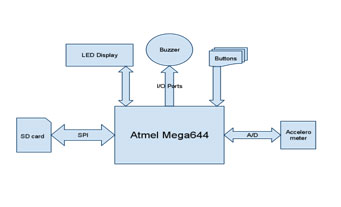As we always say, with technology you are always a step ahead. Here is a high level design Adaptive Alarm Clock system designed and implemented by final year engineering students from Cornell University. This is an alarm clock that chooses the optimal time to wake up the user using an accelerometer that detects his/ her body movements. The adaptive alarm clock system is designed with an aim to improve one’s sleep by picking a good time to wake you up.
The sleep analyzer records that a human body exhibits more movements during deep sleep rather than during lighter phases of sleep. Much other information of similar notes and sleeping patterns are recorded by the accelerometer and analyzed to comprehend an appropriate wake-up time for the user. This indeed is a task that requires a smart and intelligent algorithm.
The high level design of the system is shown below:

The data recorded from the accelerometer is sent to microcontroller ATMega644 via an A/D converter. The MCU is the central brain of the alarm system which interacts with accelerometer, LED display, the buzzer for alarm, SD card and buttons. The recorded data samples are written on the SD card. With an alarm clock, keeping a track of time is very essential. Buttons are used to input current time and alarm time from the user which is displayed on the LED display. An SD card is used to back up the recorded data. It is connected to the controller with a SPI interface.
A power supply is used to drive the LED display. It is a 12V DC supply with an output current of 1A.
The Software design of the Automatic Alarm is sub-divided into various sections like
· Keeping track of time and interfacing with the clock buttons to set time, alarm time, etc.
· Interfacing SD card and accelerometer with the microcontroller unit.
· The Wake-up algorithm
It is worth noting that no part of the system is kept in contact to the human body. Keeping the device under your pillow will suffice.
So, design a smart automatic alarm for yourself and explore new vistas of knowledge with ease.
Filed Under: Reviews


Questions related to this article?
👉Ask and discuss on EDAboard.com and Electro-Tech-Online.com forums.
Tell Us What You Think!!
You must be logged in to post a comment.